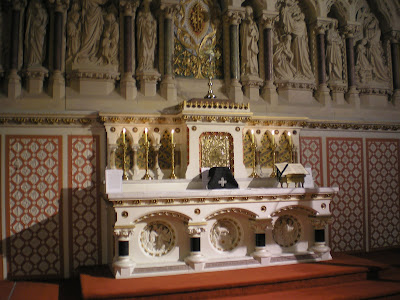No, I’m not Irish. Nor do I have Irish ancestors.
This litany unlike the private litanies sometimes found in prayerbooks (and on the Internet) is public and was approved by special concession of Benedict XV. It ranks therefore, along with the public litanies of the Church such as Litany of Loreto, the Holy Name, St. Joseph, the Sacred Heart and the Precious Blood.
The litany follows first a liturgical order. The Blessed Virgin Mary, St. Joseph as Patron of the Universal Church, then the martyrs, pontiffs, confessors, monks, virgins, etc. The list was limited to those Irish saints with a Proper Mass and Office.
Within the list, another order is observed. For the Pontiffs and Confessors, in the first place is St. Celestine who sent St. Patrick, and then of course, St. Patrick himself. The follow all the other saints according to the ecclesiastical provinces. Each archdiocesan group (total 4) is headed by the patron saint, followed by the patrons of the dioceses, etc. That has led to St. Colman being invoked thrice and the innovation of the not-so-Irish St. Nicholas
ARMACANA.
E~mus et R~mus Dominus Cardinalis Michael Logue, Archiepiscopus Armacanus et Primas Hiberniae a Sanctissimo Domino nostro Benedicto Papa XV supplex petivit, ut Litanias Omnium Sanctorum Hiberniae humiliter exhibitas approbare dignaretur in usum omnium Hiberniae Ecclesiarum. Sanctitas porro Sua, referente infrascripto Cardinal Sacrae Rituum Congregationi Praefecto, suprascriptas Litanias de Sanctis Hiberniae ab eodem Sacro Concilio revisas ac dispositas, approbavit, earumque usum in Ecclesiis totius Hiberniae, de speciali gratia, benigne concedere dignata est. Contrariis non obstantibus quibuscumque.
Die 9 Martii 1921.
+ A. CARD. Vico, Ep. Portuen.,
Praef.
ALEXANDER VERDE,
S. R. C. Secretarius
LITANIAE SANCTORUM HIBERNIAE.
Kyrie, eleison.
Christe, eleison.
Kyrie, eleison.
Christe, audi nos.
Christe, exaudi nos.
Pater de coelis Deus, miserere nobis
Fili Redemptor mundi Deus, miserere nobis
Spiritus Sancte Deus, miserere nobis
Sancta Trinitas unus Deus, miserere nobis
Sancta Maria, ora pro nobis
Sancta Dei Genitrix,
Sancta Virgo virginum,
Sancte Joseph,
Sancte Kiliane,
Sancte Rumolde,
Sancte Livine,
Beate Oliveri
Omnes Sancti Martyres, orate pro nobis
Sancte Caelestine, ora pro nobis
Sancte Patrici,
Sancte Malachia,
Sancte Machanisi,
Sancte Finiane,
Sancte Mele,
Sancte Macartine,
Sancte Eugeni,
Sancte Colmane,
Sancte Fedlimine,
Sancte Eunane,
Sancte Laurenti,
Sancte Conlethe,
Sancte Laseriane,
Sancte Edane,
Sancte Kirane,
Sancte Alberte,
Sancte Albee,
Sancte Colmane,
Sancte Finbarre,
Sancte Flannane,
Sancte Munchine,
Sancte Fachanane,
Sancte Otterane,
Sancte Carthage,
Sancte Jarlathe,
Sancte Nathaee,
Sancte Asice,
Sancte Nicolae,
Sancte Colmane,
Sancte Muredache,
Sancte Declane,
Sancte Virgili,
Sancte Senane,
Sancte Frigidiane,
Sancte Cuthberte,
Sancte Ruperte,
Sancte Celse,
Sancte Catalde,
Sancte Donate,
Beate Thaddaee,
Omnes Sancti Pontifices et Confessores, Orate pro nobis.
Sancte Columba, ora pro nobis
Sancte Coemgene,
Sancte Brendane,
Sancte Canici,
Sancte Kirane,
Sancte Columbane,
Sancte Galle,
Sancte Fursee,
Sancte Fintane,
Sancte Comgalle,
Sancte Fiacri,
Omnes Sancti Monachi et Eremitae, orate pro nobis
Sancta Brigida, ora pro nobis
Sancta Ita,
Sancta Attracta,
Sancta Dympna,
Sancta Lelia,
Omnes Sanctae Virgines, orate pro nobis
Omnes Sancti et Sanctae Dei, Intercedite pro nobis.
Agnus Dei, qui tollis peccata mundi, Parce nobis Domine.
Agnus Dei, qui tollis peccata mundi, Exaudi nos Domine.
Agnus Dei, qui tollis peccata mundi, Miserere nobis.
V. Orate pro nobis omnes Sancti Hiberniae
R. Ut digni efficiamur promissionibus Christi.
Oremus.Gratiam tuam, Domine, multiplica super nos, commemorationem celebrantes omnium Insulae nostrae Sanctorum ; ut quorum esse cives gratulamur in terris, cum his mancipatum habere mereamur in coelis. Per Dominum.
The official English translation:
The Litany of Irish SaintsLord, have mercy on us.
Christ, have mercy on us.
Lord, have mercy on us.
Christ, hear us.
Christ, graciously hear us.
God the Father of Heaven, have mercy on us.
God the Son, Redeemer of the world, have mercy on us.
God the Holy Ghost, have mercy on us.
Holy Trinity one God, have mercy on us.
Holy Mary, pray for us
Holy Mother of God,
Holy Virgin of virgins,
St. Joseph,
St. Killian,
St. Rumold,
St. Livinus,
Blessed Oliver,
All ye Holy Martyrs,
St. Celestine,
St. Patrick,
St. Malachy,
St. Macnise,
St. Finnian,
St. Mel,
St. Macartan,
St. Eugene,
St. Colman,
St. Felim,
St. Eunan,
St. Laurence,
St. Conleth,
St. Laserian,
St. Aidan,St. Kieran,
St. Albert,
St. Ailbe,
St. Colman,
St. Finnbarr,
St. Flannan,
St. Munchin,
St. Fachtna,
St. Otteran,
St. Carthage,
St. Jarlath,
St. Nathy,
St. Asicus,
St. Nicholas,
St. Colman,
St. Muredach,
St. Declan,
St. Virgilius,
St. Senan,
St. Frigidian,
St. Cuthbert,
St. Rupert,
St. Celsus,
St. Cataldus,
St. Donatus,
Blessed Thaddaeus,
All ye Holy Pontiffs and Confessors,
St. Columba,
St. Kevin,
St. Brendan,
St. Canice,
St. Kieran,
St. Columbanus,
St. Gall,
St. Fursey,
St. Fintan,
St. Comgall,
St. Fiacre,
All ye Holy Monks and Hermits,
St. Brigid,
St. Ita,
St. Attracta,
St. Dympna,
St. Lelia,
All ye Holy Virgins,
All ye Holy Saints of God, Intercede for us.
Lamb of God, Who takest away the sins of the world, Spare us, O Lord.
Lamb of God, Who takest away the sins of the world, Graciously hear us, O Lord.
Lamb of God, Who takest away the sins of the world, Have mercy on us.
V. Pray for us, all you Saints of Ireland.
R. That we may be made worthy of the promises of Christ.
Let us pray. Grant, O Lord, an increase of Thy Grace to us who celebrate the memory of all the Saints of our Island ; that as, on earth, we rejoice to be one with them in race, so, in Heaven, we may deserve to share with them an inheritance of bliss. Through Christ Our Lord. Amen.
Published in August, 2007
































































